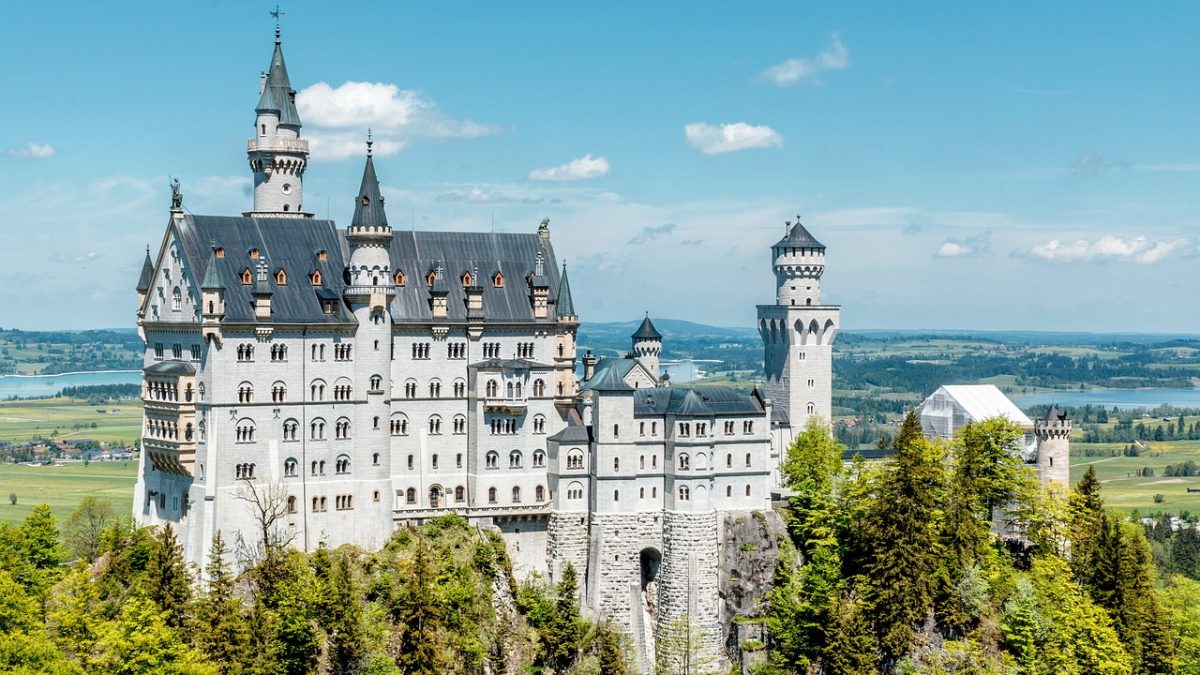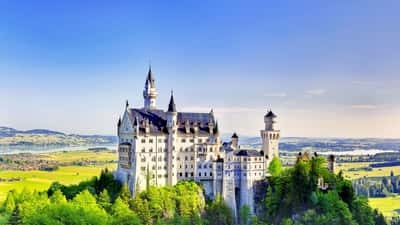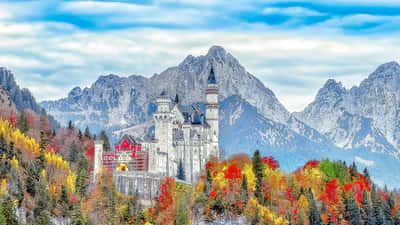Architectural Marvel: Uncover the Beauty of Neuschwanstein Castle and London

Neuschwanstein Castle: A Bavarian Fairytale
History and Construction of Neuschwanstein Castle
Neuschwanstein Castle, nestled in the Bavarian Alps, was commissioned by King Ludwig II in the 19th century. Construction began in 1869 but was never fully completed. Ludwig’s vision was to create a romantic dream castle inspired by the operas of Richard Wagner. Positioned atop a rugged hill, the castle’s dreamlike architecture attracts millions of visitors each year.
Architectural Features and Design Elements
The architecture of Neuschwanstein is a stunning blend of various styles, notably Romanesque and Gothic. Key features include:
- Towering Turrets: Give the castle its fairytale appearance.
- Intricate Interiors: Elaborately decorated rooms, each telling a story.
- Panoramic Views: With balconies and terraces designed to take in the breathtaking surroundings.
Significance and Legacy of Neuschwanstein Castle
Neuschwanstein Castle has become a symbol of romantic architecture and a representation of Bavarian folklore. Its legacy endures in popular culture, inspiring numerous films and fairy tales. The castle serves as a poignant reminder of King Ludwig II’s enchanting imagination and remains a cherished cultural landmark. Today, it stands as a testament to historical grandeur, attracting tourists who seek a glimpse into a fairy tale brought to life.

Exploring Neuschwanstein Castle
Interior Highlights and Rooms to Discover
Stepping inside Neuschwanstein Castle feels like entering a world of magic. Notable rooms include:
- The Throne Room: Grand and opulent, adorned with stunning chandeliers.
- The Singing Room: A delightful space designed for musical performances.
- The Bedroom: Showcases intricate woodwork and an enchanting ceiling mural.
Each room reflects Ludwig’s artistic vision and provides a glimpse into his life.
Surrounding Landscape and Scenic Views
The castle is surrounded by majestic mountains, lush forests, and serene lakes, offering breathtaking views from various vantage points.
- Marienbrücke Bridge: This famous bridge provides a panoramic view of the castle and its backdrop.
- Hiking Trails: Experience nature through scenic hiking paths that lead to idyllic viewpoints.
Visitors can relish the beauty of nature, further enhancing their experience.
Visiting Tips and Practical Information
Planning a visit to Neuschwanstein Castle can be a delightful adventure. Here are some useful tips:
- Book Tickets in Advance: To avoid long lines, purchasing tickets online is highly recommended.
- Dress Comfortably: Wear walking shoes as exploring the castle and surroundings involves some trekking.
- Timing: Early morning or late afternoon visits are ideal for fewer crowds.
With these insights, exploring Neuschwanstein Castle can turn into an unforgettable fairytale experience.

London : A Blend of Tradition and Modernity
Historical Background and Evolution of London
London’s history dates back over two millennia, originally established by the Romans as “Londinium.” Since then, it has undergone significant transformations:
- The Middle Ages: The growth of trade and the establishment of the Tower of London as a royal fortress.
- The Great Fire of 1666: A catastrophic event that led to the rebuilding of much of the city.
- Modern Developments: The rise of skyscrapers and innovative architecture, merging the old with the new.
This rich tapestry of history creates a city that feels both ancient and contemporary.
Iconic Landmarks and Architectural Wonders
Walking through London, you encounter a striking contrast in architectural styles. Highlights include:
- The Tower of London: A historic fortress with deep-rooted significance.
- The Shard: A modern skyscraper that offers breathtaking city views.
- Buckingham Palace: The iconic residence of the British monarch, representing royal tradition.
These landmarks tell the stories of London’s evolution through the centuries.
Cultural Diversity and Vibrant Neighborhoods
London’s neighborhoods reflect a vibrant cultural tapestry, each offering unique experiences.
- Chinatown: Bursting with culinary delights and colorful markets.
- Camden Town: Known for its eclectic market and artistic vibe.
- Notting Hill: Famous for its annual carnival and charming pastel-colored houses.
Each area invites exploration and showcases the city’s multicultural identity, making it a dynamic place to visit. London harmoniously blends tradition and modernity, creating a captivating atmosphere that resonates with everyone.

Discovering London’s Architectural Marvels
The Tower of London: A Historic Fortress
The Tower of London stands as a testament to the city’s storied past. This UNESCO World Heritage Site has served various roles, from royal palace to prison. Visitors can stroll through its historic walls and discover:
- The Crown Jewels: A glittering collection housed within.
- The White Tower: The oldest part, showcasing medieval military architecture.
- Yeoman Warders: Engaging guides sharing captivating stories of intrigue and legend.
Walking through the Tower feels like stepping back in time, immersing visitors in the rich history of England.
The Shard: A Contemporary Skyscraper
In stark contrast, The Shard piercing the London skyline represents modern architectural brilliance. Completed in 2013, this impressive structure boasts:
- Observation Deck: Offering 360-degree views of the city.
- Innovative Design: Created by architect Renzo Piano, it reflects London’s forward-thinking ethos.
Experiencing the view from the top, one can appreciate the seamless integration of past and present.
The Houses of Parliament and Big Ben: Symbols of London
No visit to London is complete without marveling at the Houses of Parliament and the iconic Big Ben. This historic building showcases stunning Gothic Revival architecture and houses the UK Parliament. Key highlights include:
- The Great Clock Tower: Known affectionately as Big Ben, it rings out across the Thames.
- Westminster Hall: The oldest part of the complex, steeped in history.
These landmarks are not only architectural wonders but also symbols of British democracy and culture, epitomizing the charm and grandeur of London.

Contrasting Architectural Styles: Neuschwanstein Castle vs. London
Aesthetic Differences and Influences
The architectural styles of Neuschwanstein Castle and London present a fascinating contrast. Neuschwanstein embodies a romantic, fairytale-like aesthetic, characterized by ornate towers and whimsical features inspired by medieval designs. In contrast, London showcases a variety of styles ranging from the Gothic revival of the Houses of Parliament to the sleek modernity of The Shard.
- Neuschwanstein: Dreamlike, ornate, lush landscapes.
- London: Diverse, reflecting centuries of history and innovation.
Each site tells a unique story of its era and culture, revealing the artistic influences of their times.
Cultural Context and Regional Characteristics
The cultural context behind these architectural styles highlights their regional characteristics. Neuschwanstein, situated in the Bavarian Alps, reflects Romanticism’s longing for idealized beauty and nature. Conversely, London’s architecture speaks to centuries of evolution, influenced by power, commerce, and societal change.
- Bavaria: Enchanted castles symbolize royalty and folklore.
- London: Adaptive architecture representing a melting pot of cultures.
Both places, despite their differences, reveal how history shapes architectural identity.
The Impact of Architecture on Tourism and Identity
Architecture significantly impacts tourism and cultural identity. Neuschwanstein Castle is a top draw for those seeking a glimpse of a Bavarian fairy tale, attracting millions each year. Similarly, London’s landmarks are essential to its identity, drawing visitors from around the globe.
- Visitor Experience: Each site offers distinct vibes and stories, fostering unique connections.
- Cultural Pride: Architecture reinforces local identity and heritage.
Thus, the contrasting styles of Neuschwanstein and London not only delight the eyes but also deepen our understanding of the cultures they represent.










